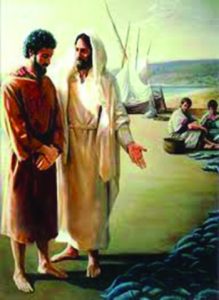A School for Prayer (24) – Spiritual Guidance (3 of 3)
The ancient tradition of the spiritual life
By Fr Craig Larkin SM, 1943 - 2015
What does the disciple need to do?
1. The disciple should search carefully for a spiritual father
St Symeon the New Theologian says that there are two ways of finding the energy of the Spirit that we received in Baptism:
a) By observing the commandments and by personal asceticism;
b) By placing oneself under a spiritual guide.
“The first way is longer”, he says, “the second is very short, provided that we have learned to prepare the ground of our heart and soul”.
“Make every effort to seek the company of experienced spiritual fathers and to be guided by them. For it is dangerous to isolate oneself completely, relying on one’s own judgement with no one else as witness”. (Mark the Ascetic)
“I don’t know of any fall of a person that was not caused by self-confidence. Do you see someone fall? Know that he is directing himself. …
Nothing is more serious than to direct oneself; nothing is more fatal.”
Dorotheus of Gaza.
2. The disciple should take responsibility for his own life
The spiritual guide helps us to make our own journey: He/she is not a substitute for our own efforts and self-knowledge.
In modern terms, it is the disciple who must provide the agenda for spiritual guidance.
The spiritual father helps the disciple to make his/her own journey.
“A brother said to Abba Antony: ‘Pray for me.’
The Abba replied, ‘I will have no mercy on you, nor will God have any, if you yourself do not make an effort and if you do not pray to God yourself.’
Sayings. Antony 16
“If unclean thoughts trouble you, do not hide them but tell them at once to your spiritual father…. The more we conceal our thoughts, the more they multiply and gain strength. … But once a thought is revealed, it is immediately dissipated. … Whoever discloses his thoughts is quickly healed.”
Sayings of the Desert Fathers.
3. The disciple needs to be aware and attentive
The disciple needs
• to listen to the voices around him and inside him;
• to notice what is happening to him and in him;
• to be aware of what is going on inside himself;
• to “read” the logismoi that find space in his head.
4. The disciple needs to manifest his thoughts to his father
The spiritual father’s gift of discernment becomes effective when the disciple “discloses his thoughts” (logismoi). This is the process of examologesis.
Manifestation of thoughts is broader than sacramental Confession. The disciple speaks of ideas and impulses which may seem innocent to him, but in which the spiritual father may recognize hidden dangers or significant signs.
Confession is retroactive: it deals with sins already committed.
Manifestation of thoughts is pro-active: it lays bare our logismoi before they have become actions of sin.
The purpose of manifestation of thoughts is not to secure absolution from guilt, but to seek self-knowledge, so that we see ourselves as we really are.
Wounds which have been declared do not become worse.
“Brother, ask God insistently to show you someone able to direct you well, to whom you must listen as to God himself while accomplishing without hesitation everything he tells you.”
Symeon the New Theologian
5. The disciple needs to follow the guidance of his father
Obedience to one’s Abba was a matter of strict necessity in the Desert tradition.
Such obedience was not aimed at creating an infantile dependency on the Abba, but rather of allowing the Abba scope to exercise his gifts of diakrisis and love, and to enable the disciple to walk in humility before God.
When the disciple’s manifestation of thoughts meets the Abba’s gift of discernment, then new life in the Spirit grows in the disciple.
What if a disciple cannot find a master?
Thomas Merton describes a significant problem:
“Spiritual directors are not easy to find, even in the religious life. Even where there are several priests at hand, this does not mean that they are all suitable as “directors”. The scarcity of really good spiritual directors for religious may perhaps account for the magnitude of the problems in certain communities. No doubt many losses of vocation could have been prevented by a really solid and firm spiritual direction in the first years after novitiate”. (Paper: “Spiritual Direction” Website: “Spiritual Direction – Thomas Merton”)
1. A first possibility – books
The Fathers advise that if no guide can be found, reading is a possible substitute: primarily Scripture. But books are written for a general readership; whereas a human guide gives personalized guidance. If it is impossible to find a personal guide, try at least to find someone who can guide our reading.
2. A second possibility – places
Sometimes, making serious visits to places of holiness can help in our spiritual journey.
3. A third possibility – community support
Immersing oneself fully – even if for a short time – in the spiritual rhythm of a community can provide the atmosphere a person needs to re-order his/her life, or make a significant decision.
NOTE!
Beware of the possibility of self-deception!
Often people imagine or claim that they cannot find someone. What they really mean is that they expect some guru, and they don’t see the guides that God is sending to them right under their noses.
Or sometimes a person “can’t find” a director because he doesn’t want to face the very thing a director might help him to confront. The answer to their problem is already in their heart, but they don’t like the answer.
The Icon of Jesus and Peter – the path of spiritual direction
The Icon of Jesus with Peter says something of the experience of Spiritual Direction
Peter stands alongside Jesus in companionship with Him.
The feet of Jesus and the feet of Peter indicate that they are both setting out on a journey – together.
Peter has left his boats behind; his feet are set on a new path. But his left hand still clings to his net, a symbol of his former way of life where he finds his security. His right hand is in the traditional gesture of prayer or listening.
Jesus is alongside him, close to him. His left hand is on Peter’s shoulder in a gesture of intimacy and friendship. His right hand blesses Peter, indicating that Peter’s new journey is a journey of the Spirit. Wherever this journey takes Peter, Jesus will be with him.
The eyes of Peter and the eyes of Jesus are fixed on each other. It is the voice of Jesus that Peter listens to, and the face of Jesus that Peter searches for. 

 Entries(RSS)
Entries(RSS)